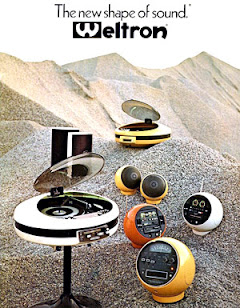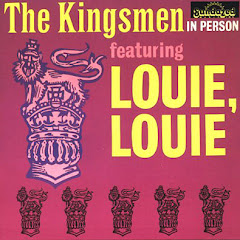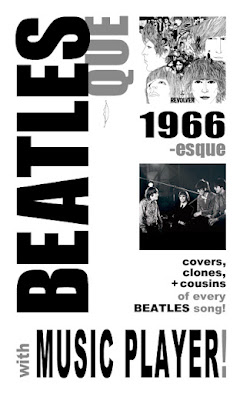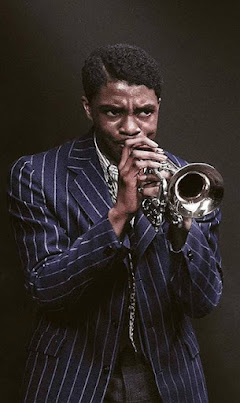Music Players!
brings you the actual, all-inclusive
history of Rock'n'Soul music,
with essay overviews and Music Players.
▶ History Checklist
Today, the jaunty Jimmy Reed, the groover of Rock!
Hear 2 extensive music players, one of Reed and one of all his disciples from the 1950s to today!
Music Player quick-links:
𝟭 Jimmy Reed
𝟮 Jimmy Reed's disciples: 1950s-Today
ROCKIN' WITH REED!:
The Music of Jimmy Reed
The "Sesame Street" theme and many other famous songs we love all exist because of one Blues man.
Sometimes you can tell a history of Rock'n'Soul through the influence of one guitarist, or one voice, or one beat, or one song, or a groove. Jimmy Reed trademarked a groove that defined generations of music afterward.
by Tym Stevens
Jimmy Reed was an unassuming gentle soul who raised up a lot of noise and ripples.
A Mississippi blues man, a peer in the new 1950s electric wave of John Lee Hooker, Muddy Waters, and Howlin' Wolf, Jimmy regularly galloped hits and standards into the pop charts alongside upstart colts like Chuck Berry> and Bo Diddley>. Catchy, no frills, all thrills. Jimmy bridged the worlds of Rock and Blues exactly as the first youth of Rock'n'Roll> were learning to play.
Jimmy had a sweet disposition, like a cherished uncle talking loose, that felt like casual confessionals of hidden depth. He was a whisper and a smile, a gas and a groove. You could catch the melody, dance to it, and play it. Many many did and do.
He rolled out classics like printing money. "Ain't That Lovin' You, Baby?", "Baby, What You Want Me To Do?", "Bright Lights Big City", "Big Boss Man", "I Ain't Got You", "Shame, Shame, Shame". Each one pinballs the skull, tickles the tongue, taps the feet.
He was a good soul with a fine run and some bad breaks. And in the long run he was great.
AIN'T THAT LOVIN' YOU, BABY!:
The Disciples of Jimmy Reed
by Tym Stevens
Hear the unlimited Playlist here.)
influenced by Chuck Berry, including:
Link Wray • Dale Hawkins • Dale Hawkins
Marvin Gaye • Everly Brothers • Sam Cooke
Barbara Lynn • Lonnie Mack • Etta James
Rolling Stones • Jackie Wilson • Velvelettes
The Animals • Soloman Burke • Los Brincos
Them • Sly + The Family Stone • Moody Blues
Bob Dylan • The Ad Libs • Beach Boys
Booker T And The MGs • The Pretty Things
Shangri-Las • The Standells • Irma Thomas
Piero Piccioni • Small Faces • Capt. Beefheart
Stevie Wonder • Wilson Pickett • Elvis
The Who • John Mayall • The Who
Shangri-Las • The Standells • Bobbie Gentry
Frank Zappa • Jimi Hendrix • Charlie Rich
The Doors • T.Rex • The Grateful Dead
Freddie King • Aretha Franklin • The Byrds
Jim Croce • John Lennon • Chicago • ZZ Top
Koko Taylor • Bryan Ferry • Joe Sample
Blues Brothers • Clifton Chenier • Stray Cats
Neil Young • Elvis Costello • Half Japanese
Meat Puppets • Lyres • The Delmonas
Paul McCartney • Thee Headcoatees
Eddie Clearwater • Bodeco • Jeff Beck
James Blood Ulmer • The Kills • HeadCat
Willie Nelson • Wynton Marsalis • Oasis
Rosie Flores • Barrence Whitfield
Black Joe Lewis • Gary Clark Jr • Nikki Hill
The Baboons • Tony Joe White • Don Bryant
and many, many more!
Jimmy Reed is the mover and the groover. His easy-to-learn chords, earworm tunes, and amiable candor cut the baby teeth of Blues, Rock, and Soul folks for the long stroke.
His classic songs have been routinely covered from the late-'50s up to this day. You'll even hear the young Jackson 5 (1967) learning how to play to Jimmy Reed!
The Jimmy Reed groove is a boogie shuffle that was becoming standard in Blues and the emerging Rock in the mid-'50s. He stamped it with his stark directness, catchy simplicity, and leisurely ease. He took such sonic possession of it, or it him, that it became hard to believe it ever existed without him.
After his first strutting hits, it started to diverge into two tempos, each of which launched many covers and imitations: e.g., the slow stroll of "Bright Lights Big City", and the sunny jaunt of "Big Boss Man".
The BRIGHT LIGHTS BIG CITY Groove
Jimmy Reed turned the standard slow blues shuffle into a stripped, insular, smokey mood. It's the sound of shack backrooms, creaking floors and bones, raspy regrets, and woozy funk. It can be wandering midnight city cement, lost and glazed, on the wrong side of downhill. Or it can be sinuous and sultry, or lazed and content, or drunk and drained. It starts in rough Rockin' form on "I Found My Baby", simmers down on "Baby, What You Want Me To Do" and "Take Out Some Insurance", and reaches pure slow burn with "Bright Lights Big City". The groove and the mood becomes his through the spare atmosphere, languid vocal, and bleak harp.
You can hear this groove and mood play out in other classics like The Yardbirds' "Like Jimmy Reed Again", The Rolling Stones' "The Spider And The Fly", Ray Hoff and The Offbeats' "My Good Friend Mary Jane" (Australia), Chicago's "Anyway You Want", and in mutant spirit in Bob Dylan's "Rainy Day Women #12 & 35" and ZZ Top's "Tush", or Half-Japanese splicing their cover with The Ventures' "Walk Don't Run".
The BIG BOSS MAN Groove
(or, "Can You Tell Me How To Get Some Respect For Jimmy Reed?")
But it's the jaunty groove that everyone loves, even if they don't realize it's origin.
It's especially odd that songs influenced by 'the Bo Diddley' beat>' are named, noted, and archived routinely, but no one seems to do the same for the upbeat Jimmy Reed groove. Yet it's often as ubiquitous.
It is paralleled early by similar groovers like Little Walter's "My Babe", Chuck Berry's "You Can't Catch Me" and "Memphis, Tennesse"*, and Little Willie John's "Leave My Kitten Alone". But Jimmy distills the blues jaunt into a classic rhythm with "Big Boss Man" (1960). He refines it with "Baby What's Wrong" (1961) and perfects it on "Shame, Shame, Shame" (1963).
* (One critic contends that all of the songs I will ascribe as the Jimmy Reed jaunt are just variations of Chuck Berry's "Memphis, Tennessee". But I would respectfully counter this by expanding it. Rather than the false borders of antithesis, this is the fluid reality of synthesis in action.
Chuck's original was a 1959 b-side that sounds like a proto sketch, more of a straight jog than a jaunt, and was rarely heard. Only after Lonnie Mack (1963) and Johnnie Rivers (1964) had hit covers with it that skewed closer to Jimmy's rhythm did the song become famous, and even Chuck then changed how he played it after their lead. Creativity is endless synthesis. Note that Lonnie covered Jimmy's "Baby, What's Wrong" with the signature jaunt on the same album, and how much of Reed he brought into his very loose cover of "Memphis". So I contend that Jimmy Reed, though perhaps initially influenced by his peer Chuck, crystalized the rhythm that everyone will continue to expand on. But I've included all on the player for your own estimation.)
As Jimmy furrows the major groove, it mirrors in minor sides like The Esquires' "The Sight Of You", Cheryl and Pam John's "That's My Guy", and The Crickets' "All Over You". Even as Jimmy lay tread with "Shame, Shame, Shame", Tommy Tucker was on his heels with "Hi-Heel Sneakers".
It bops into the popstream with Marvin Gaye's "Can I Get A Witness?", laces loose in The Velvelettes' "Needle In A Haystack", and parties up Solomon Burke's "Everybody Needs Somebody To Love".
But it probably reaches critical mass with The Ad Libs' "The Boy From New York City" (1965). By then it's a standard rhythm underscoring acolytes like Jean Wells' "Put The Best On The Outside" and answer songs like The Beach Boys' "The Girl From New York City". By now it's international, like Roy Head's "Apple Of My Eye" (England) and Los Johnny Jets' cover "El Leon" (Mexico), Les Furys' "Aide-Moi" (Canada), The Times' "Glad Not Sad" (Australia), and Datar's "Alveg ær" (Iceland).
This is the juncture in creative interchange when covers become clones become cousins. It goes from covers like The Pretty Things' or Bobbi Gentry's "Big Boss Man"; to clones like The Olympics' "We Go Together (Pretty Baby)" and The Arthur Brown Set's "The Green Ball"; to cousins like Booker T & The MGs' "Outrage", The Standells' "Dirty Water", The Ad Libs' "He's No Angel", The NightRiders' "Love Me Right Now", and Black Joe Lewis' "Black Snake".
Two cool things birth a third cool thing. Just as Jimmy echoed the blues shuffle in his own way, others reverbed his way into their way, and then all of them started to ricochet with each other. The Stones channel the Jimmy jaunt via Marvin Gaye with their response "Now, I've Got A Witness". Sugar Pie DeSanto gets there by answering "Hi-Heel Sneakers" with "Soulful Dress", as do Oasis with "(Get Off Your) High Horse Lady". The young Sly And The Family Stone strut Willie Mabon's "Seventh Son" sidelong into the Jimmy jaunt. Inez and Charlie Foxx burn into "Hurt By Love" by way of Martha And The Vandellas' "Heatwave". Shirley & Company cross Jimmy with Bo Diddley in their "Shame, Shame, Shame". Elvis Costello gets there in "Tokyo Storm Warning" by way of The Stones' "Satisfaction". Thee Mighty Caesars broadcast "Signals Of Love" on waves of Link Wray.
Cross-fertilization is how creativity (and culture, and the human lineage) works.
The universality of the groove paved the way for the TV theme, "Can You Tell Me How To Get To SESAME STREET?" (1969), by Joe Raposo. The series began as a counterculture response to MISTER ROGER'S NEIGHBORHOOD, with an urban slant emphasizing diversity in the cast, film mediums, and especially music styles. Raposo was excellent at underscoring all of the segments with folk, jazz, blues, soul, rock, and more, a subtle music education for budding minds. Having the pulse of the times, he would have been aware of the Jimmy Reed jaunt in some form. So there it shines in a sunny tune that beamed itself into the cultural DNA of five decades of children.
Today is brought to you by the letter G, for Groove!
© Tym Stevens
See Also:
• Revolution 1950s: The Big Damn Bang of Rock'n'Roll!
• 1950s PUNK: Sex, Thugs, and Rock'n'Roll!
• CHUCK BERRY: The Guitar God and His Disciples
• BO DIDDLEY: The Rhythm King and His Disciples
• BUDDY HOLLY: Rock's Everyman and His Disciples
• LITTLE RICHARD: The Voice of Rock and His Disciples
• The Real History of Rock and Soul!: A Manifesto, A Handy Checklist





































































































































No comments:
Post a Comment